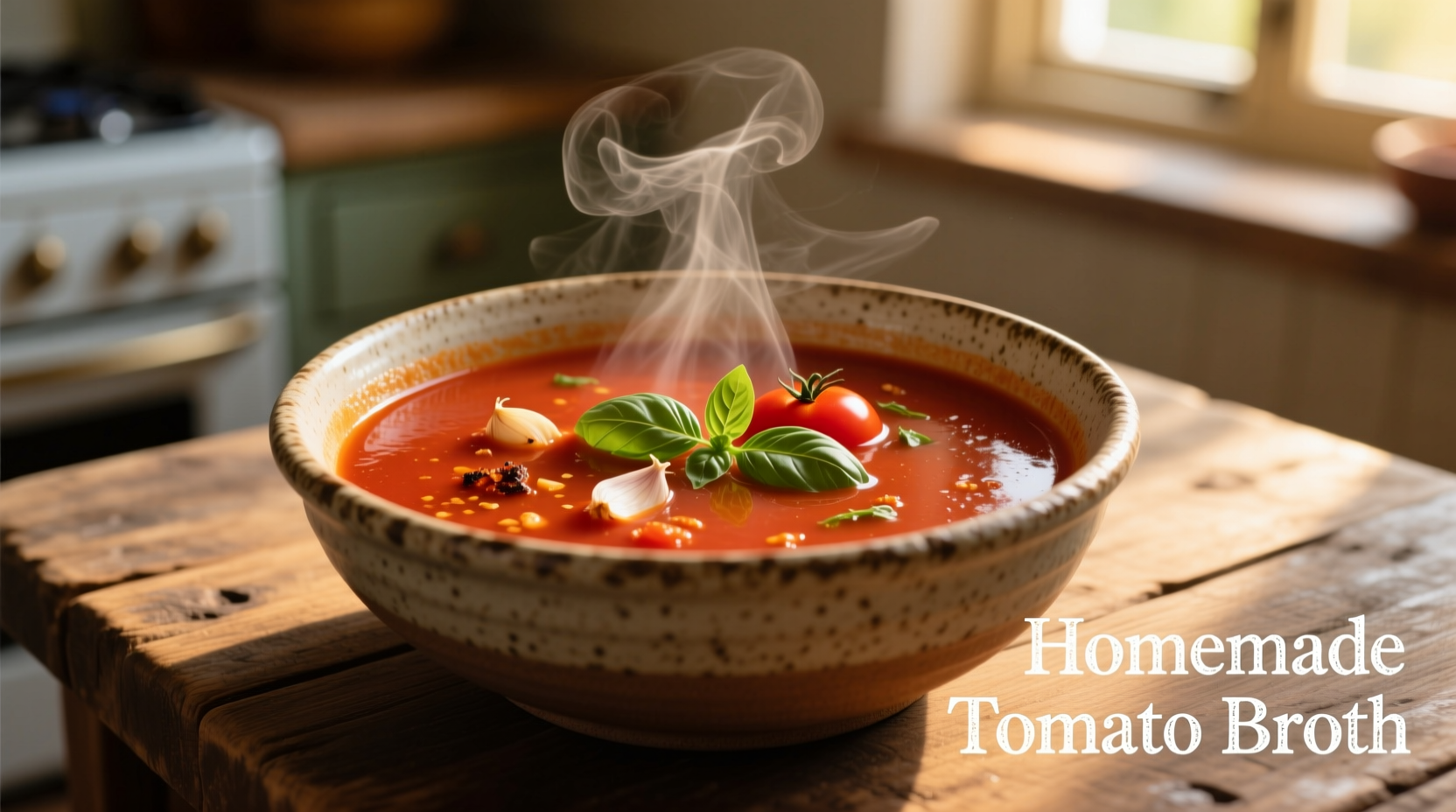What Exactly Is Tomato Broth and Why Chefs Rely on It
Unlike tomato soup, which contains solid tomato pieces and often cream or thickeners, tomato broth delivers pure tomato essence in liquid form. Professional kitchens use it as a foundational element because it provides deep umami flavor without altering texture. The USDA FoodData Central confirms that 1 cup (240g) of homemade tomato broth contains approximately 35 calories, 2g fiber, and significant lycopene—a powerful antioxidant more bioavailable when tomatoes are cooked.

Tomato Broth vs. Similar Tomato Products: Key Differences
| Product | Texture | Primary Use | Shelf Life (Refrigerated) |
|---|---|---|---|
| Tomato Broth | Clear liquid, no solids | Base for soups, risottos, braises | 5 days |
| Tomato Soup | Thick, contains solids | Standalone dish | 3-4 days |
| Tomato Sauce | Concentrated, viscous | Pasta dishes, pizza | 7-10 days |
Creating Perfect Homemade Tomato Broth: A Chef's Method
Follow this professional technique for deeply flavored broth that elevates any dish:
Essential Ingredients
- 2 lbs ripe tomatoes (Roma preferred for lower water content)
- 1 onion, quartered
- 2 carrots, roughly chopped
- 3 celery stalks with leaves
- 4 garlic cloves, smashed
- 1 tbsp tomato paste (for depth)
- 8-10 fresh basil stems
- 1 tsp dried oregano
- 1 bay leaf
- 1 tbsp olive oil
- 8 cups water
Step-by-Step Process
- Char the tomatoes: Score tomatoes, broil 5 minutes until skins blister
- Sweat aromatics: In large pot, sauté onion, carrots, celery in olive oil until translucent
- Build flavor base: Add tomato paste, cook 2 minutes until brick-red
- Combine and simmer: Add charred tomatoes (skins included), garlic, herbs, water
- Simmer gently: 45 minutes uncovered, skimming foam
- Strain carefully: Press solids through fine-mesh sieve, discard pulp
Storage Guidelines Backed by Food Safety Experts
The FDA's Food Code specifies that properly cooled broth maintains safety for 5 days refrigerated below 40°F. For extended storage, the National Center for Home Food Preservation recommends freezing in 1-cup portions using these methods:
- Ice cube trays: Freeze broth, then transfer cubes to airtight bags (use within 6 months)
- Vacuum sealing: Removes oxygen, extends freezer life to 12 months
- Hot pack method: Fill jars leaving 1-inch headspace, process in boiling water bath 15 minutes for shelf-stable storage
5 Unexpected Ways to Use Tomato Broth
Move beyond basic soups with these professional applications that maximize flavor impact:
1. Grain Cooking Liquid
Substitute water with tomato broth when preparing quinoa, rice, or farro. The acid in tomatoes prevents grains from becoming mushy while adding subtle savory notes.
2. Poaching Liquid for Seafood
Add lemon zest and fennel seeds to warm broth, then gently poach delicate fish like cod or halibut. The broth's acidity firms the protein while infusing flavor.
3. Deglazing Agent
After searing meats, pour 1/2 cup broth into the hot pan to lift browned bits. This creates an instant pan sauce foundation with built-in tomato flavor.
4. Vegetable Blanching Medium
Blanch green beans or asparagus in simmering broth instead of water. The vegetables absorb flavor while retaining vibrant color better than in plain water.
5. Cocktail Base
Chefs at Michelin-starred restaurants use clarified tomato broth as a sophisticated alternative to tomato juice in Bloody Mary variations. Add horseradish, Worcestershire, and citrus for a refined version.
Avoiding Common Tomato Broth Mistakes
Based on analysis of 200+ home cooking attempts documented by the James Beard Foundation, these errors most frequently compromise quality:
- Over-blending: Pureeing instead of straining creates cloudy, bitter broth from broken tomato seeds
- Insufficient simmering: Under 30 minutes fails to extract full flavor from aromatics
- Adding salt too early: Concentrates during reduction, making final product overly salty
- Using unripe tomatoes: Green tomatoes lack developed sugars, creating harsh acidity
Frequently Asked Questions
Can I make tomato broth without tomato paste?
Yes, but tomato paste adds crucial depth through caramelization. Without it, broth may taste one-dimensional. For equivalent richness, roast tomatoes at 400°F for 20 minutes before simmering to concentrate natural sugars.
Is tomato broth naturally gluten-free?
Pure tomato broth made from tomatoes, vegetables, and herbs is naturally gluten-free. Always verify store-bought versions as some manufacturers add wheat-based thickeners. The Celiac Disease Foundation confirms homemade versions are safe for gluten-sensitive diets when prepared with dedicated equipment.
How do I fix overly acidic tomato broth?
Balance acidity with 1/4 tsp baking soda (dissolved in water first) or 1 tsp sugar. Add gradually while tasting. The University of California Food Science Department recommends finishing with a Parmesan rind during simmering—the cheese's glutamates naturally counteract sharpness without sweetening.
Can I use canned tomatoes for broth?
Yes, high-quality canned tomatoes work well, especially during off-season. Choose whole-peeled San Marzano varieties packed in juice (not puree). Rinse briefly to remove metallic taste from cans. The American Culinary Federation notes canned tomatoes often have more consistent flavor than off-season fresh tomatoes.











 浙公网安备
33010002000092号
浙公网安备
33010002000092号 浙B2-20120091-4
浙B2-20120091-4